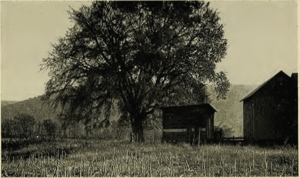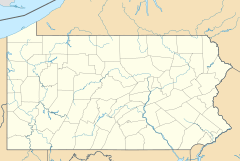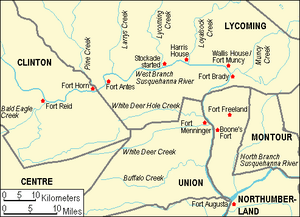Fair Play Men facts for kids
|
Pennsylvania Historical Marker
|
|

The Tiadaghton Elm in 1939, site of the Fair Play Men's Declaration of Independence
|
|
| Location | River Rd. (SR 1016 / old US 220), at Bonner Ln., SE of Avis, Pennsylvania |
|---|---|
| Nearest city | Jersey Shore, Pennsylvania |
| Coordinates | 41°10′48″N 77°16′43″W / 41.18°N 77.27865°W |
| PHMC dedicated | April 30, 1947 May 6, 1947 |
The Fair Play Men were a group of early American settlers. They lived on land that wasn't officially theirs in the West Branch Susquehanna River valley of Pennsylvania. From 1773 to 1785, they created their own rules and government.
Because they lived on land claimed by Native Americans, they couldn't ask the Pennsylvania government for help. So, they started the Fair Play System. They elected three leaders called commissioners. These commissioners made decisions about land claims and other problems for the group.
In an amazing event, the Fair Play Men wrote their own declaration of independence from Britain. This happened on July 4, 1776, under a special tree called the "Tiadaghton Elm." This tree stood on the banks of Pine Creek.
Contents
The Fair Play Men: Self-Rule in Early America
Land Disputes and Treaties
In 1768, the British government bought land from the Iroquois people. This was part of the Treaty of Fort Stanwix. This treaty opened new areas in Pennsylvania and New York for settlers. One of these areas was what is now Lycoming County, Pennsylvania. This county is about 100 miles (160 km) northwest of Philadelphia. It's also about 165 miles (265 km) east-northeast of Pittsburgh.
However, there was a disagreement about the border of this new land. Part of the western border, called the "Line of Property," was along the West Branch Susquehanna River. This line was supposed to divide colonial land from Native American land. The border was defined by a place called "Tiadaghton Creek."
The colonists said "Tiadaghton Creek" was Pine Creek. This creek was further west, which would give them more land. But the Iroquois and other tribes said it was Lycoming Creek, which was further east. The government agreed with the Native American claim. This meant all land west of Lycoming Creek was Native American land and off-limits to settlers.
Despite this, many settlers moved into the disputed area. They settled along the West Branch Susquehanna River, the west bank of Lycoming Creek, Larrys Creek, and especially near the mouth of Pine Creek. These were the Fair Play Men.
How the Fair Play System Worked
The settlers elected three commissioners every March. These leaders made sure everyone was treated fairly, which is why they were called the "Fair Play Men." Most of their decisions were about land ownership. But they also handled any other legal problems or disagreements in their area.
The commissioners gave new settlers permission to live there. If a settler left the area for more than six weeks (unless for military service), they could lose their land claim. The commissioners could also make someone leave the area entirely. Their decisions were final, and no one was supposed to challenge them.
In 1776, the three known commissioners were Bratton Caldwell, John Walker, and James Brandon. These are the only commissioners whose names we know today. Some people think they were the only three commissioners for the entire time the Fair Play system existed.
Their Own Declaration of Independence
The American Revolutionary War began in April 1775. Many men from the Fair Play area volunteered to join the Continental Army that year. Most of the settlers in the West Branch Susquehanna River valley supported the revolution.
On July 4, 1776, the Fair Play Men gathered. They met on the west bank of Pine Creek, near where it meets the West Branch Susquehanna River. There, they declared their independence from Britain. The traditional spot for this declaration was under the "Tiadaghton Elm" tree. This famous tree stood until the 1970s in what is now Clinton County, Pennsylvania. This location was west of Pine Creek, clearly on Native American land.
After their declaration, the Fair Play Men met at their own Fort Horn, which was near the elm tree. They decided to send two men to Philadelphia with their news. They didn't know that the Second Continental Congress had declared independence in Philadelphia on the very same day!
The two messengers, Patrick Gilfillen and Michael Quigley Jr., were attacked and captured by Native Americans and later jailed by Loyalists (people who supported Britain). But they managed to escape and reached Philadelphia on July 10. A short time later, they returned to share the news of the official United States Declaration of Independence.
The Big Runaway: Fleeing for Safety
During the American Revolutionary War, settlements across the Susquehanna valley faced attacks. These attacks came from Loyalists and Native Americans who were helping the British. In early summer 1778, news spread that a group of Native American warriors, possibly with British soldiers, was coming to destroy settlements in the West Branch Susquehanna River valley.
There had been smaller acts of violence against settlers. But on June 10, 1778, a group of sixteen settlers was attacked in what is now Williamsport. Twelve of them were killed. This event, along with the Wyoming Valley Massacre on July 3, 1778, caused local leaders to order everyone to leave the entire West Branch valley.
Two brave riders risked danger to warn their fellow settlers. Rachel Silverthorn volunteered to leave the safety of Fort Muncy. She rode along Muncy Creek and the Wyalusing Path, warning settlers to flee to Fort Muncy. Her own family's cabin was later burned down. Robert Covenhoven, who had served under George Washington, rode west. He warned settlers at Fort Antes and the western part of the valley. Covenhoven was a Fair Play Man and one of the people who signed the Tiadaghton Declaration of Independence.
Most settlers had already gathered at five small forts for safety. But now, these forts, along with homes and fields, were abandoned. Settlers drove their livestock and floated their belongings on rafts down the river. They went east to what is now Muncy, and then further south to Fort Augusta in Sunbury. The attackers burned the abandoned properties. Some settlers reported seeing the glow of their burning homes lighting the sky as they fled at night. Fort Horn and all the other Fair Play Men settlements were destroyed.
Some settlers returned soon after. But they had to flee a second time in the summer of 1779 during the "Little Runaway." Another group of Native Americans and British soldiers attacked the valley again. Also in 1779, Sullivan's Expedition destroyed many Native American villages in New York. This helped reduce attacks and made it safer for settlers to return.
Life After the War
The Fair Play Men and their unique system continued even after the war ended. In 1784, a second Treaty at Fort Stanwix took place. This treaty gave the Native American lands to the new United States government. It also officially recognized Pine Creek as "Tiadaghton Creek."
When the land office opened in May 1785, the Fair Play Men were no longer considered illegal settlers. Their existing land claims were officially recognized by the government.
What We Remember Today
There are no original written records from the Fair Play Men or their Declaration of Independence. However, many stories and accounts exist from later times. There are two main ideas about why no records survived. One idea is that all records were destroyed during the Great Runaway. Only one house survived in the entire West Branch valley.
Another idea is that they didn't keep records to avoid getting into trouble, since they were illegal settlers. The messengers who went to Philadelphia supposedly lost their copy of the Declaration of Independence when they were attacked or jailed.
Because there are no original written records, some modern historians wonder if the Tiadaghton Declaration of Independence actually happened on July 4, 1776. They also wonder if it was made before the Fair Play Men knew about the official United States Declaration of Independence in Philadelphia.
The closest town to the "Tiadaghton Elm" site is Jersey Shore in Lycoming County. This town holds a week-long "Town Meeting" every year around the Fourth of July. The event includes a parade with people dressed as the Fair Play Men and a special ceremony at the Tiadaghton Elm site.





